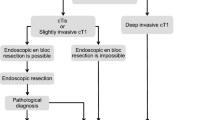Abstract
To find and eradicate synchronous neoplasms, colonoscopy was performed before and after resectional surgery in 50 patients with “occluding colorectal cancer,” defined as encroachment of the lumen by tumor to a degree that prevented passage of a colonoscope. Synchronous, frequently multiple adenomas were found in 29 (58 percent) of these patients. Three patients (6 percent) had synchronous invasive cancer as well. None of these lesions was detected by intraoperative palpation, even though 46 percent of them measured more than 1.0 cm in diameter. Synchronous neoplasms were found significantly more often in patients with occluding cancer than in patients with non-occluding cancer, investigated concurrently at the same hospital. The former patients appear to be in double jeopardy with respect to synchronous neoplasms, these being more prevalent and less accessible than in patients with non-occluding tumors. Moreover, most of the synchronous lesions are undetectable by palpation. These findings bear out the importance of early postoperative, as well as preoperative, colonoscopy in all patients with occluding colorectal cancer.
Similar content being viewed by others
References
Kronborg O, Hage E, Deichgraeber E. A prospective, partly randomized study of the effectiveness of repeated examination of the colon after polypectomy and radical surgery for cancer. Scand J Gastroenterol 1981; 16:879–84.
Gilbertsen VA, Williams SE, Schuman L, McHugh R. Colonoscopy in the detection of carcinoma of the intestine. Surg Gynecol Obstet 1979; 149:877–8.
Heald RJ, Bussey HJ. Clinical experiences at St. Mark's Hospital with multiple synchronous cancers of the colon and rectum. Dis Colon Rectum 1975; 18:6–10.
Brief DK, Brener BJ, Goldenkranz R, Alpert J, Yalof I, Parsonnet V. An argument for increased use of subtotal colectomy in the management of carcinoma of the colon. Am Surg 1983; 49:66–72.
Klatt GR, Martin WH, Gillespie JT. Subtotal colectomy with primary anastomosis without diversion in the treatment of obstructing carcinoma of the left colon. Am J Surg 1981; 141: 577–8.
Irvin TT, Greaney MG. The treatment of colonic cancer presenting with intestinal obstruction. Br J Surg 1977; 64:741–4.
Carson SN, Poticha SM, Shields TW. Carcinoma obstructing the left side of the colon. Arch Surg 1977; 112:523–6.
Dukes CE. The classification of cancer of the rectum. J Pathol Bact 1932; 35:323–32.
Kronborg O, Hage E, Deichgraeber E. The remaining colon after radical surgery for colorectal cancer: the first three years of a prospective study. Dis Colon Rectum 1983; 26:172–6.
Nava HR, Pagana TJ. Postoperative surveillance of colorectal carcinoma. Cancer 1982; 49:1043–7.
Irvin TT, Greaney MG. Duration of symptoms and prognosis of carcinoma of the colon and rectum. Surg Gynecol Obstet 1977; 144:883–6.
Author information
Authors and Affiliations
About this article
Cite this article
Bat, L., Neumann, G. & Shemesh, E. The association of synchronous neoplasms with occluding colorectal cancer. Dis Colon Rectum 28, 149–151 (1985). https://doi.org/10.1007/BF02554227
Received:
Issue Date:
DOI: https://doi.org/10.1007/BF02554227




